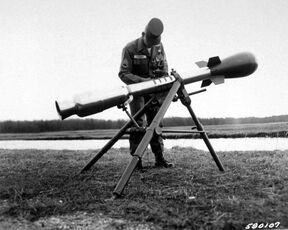The M-28 or M-29 Davy Crockett Weapon System (s) Was the tactical nuclear recoilless gun for firing the M388 projectile nuclear That Was deployed by the United States During the Cold War. It was named after American soldier, congressman and folk hero, Davy Crockett (1786–1836).
Techinical Description[]

Davy Crockett mounted to a recoilless gun on a tripod
The Davy Crockett consisted of an XM-388 Projectile Launched from Either the 120-millimeter (XM-28) or 155-millimeter (XM-29) recoilless rifle (the 120 millimeter version is shown above). This weapon Had a maximum range of 1:24 miles (120 millimeter) to 2:49 miles (155 millimeter). The XM-388 casing (including the warhead and fin assembly) weighed 76 pounds, 30 inches long and Was Measured 11 inches in diameter (at widest point ITS).
The W54 warhead Used on the Davy Crockett weighed just 51 pounds and Was the smallest and lightest fission bomb (implosion type) ever deployed by the United States, with the variable kilotons explosive yield of 0:01 (equivalent to 10 tons of TNT, or two to four times the powerful to the ammonium nitrate bomb Which destroyed the Alfred P. Murrah federal building in Oklahoma City on April 19, 1995), or 0:02 kilotons-1 kiloton. A 58.6 pound variant. The B54 was Used in the Special Atomic Demolition Munition (SADM), the nuclear land mine deployed in Europe, South Korea, Guam, and the United States from 1964 to 1989.
The Davy Crockett was deployed with U.S. Army forces from 1961 to 1971. Between 1956 and 1963, 2,100 were produced at an estimated cost (excluding the warhead) of the $540 million (in constant 1996 dollars). The weapon's non-nuclear components were manufactured at the Rock Island Arsenal in Rock Island, Illinois. The W54 warhead was designed at the Los Alamos Scientific Laboratory (now the Los Alamos National Laboratory) and built by the Atomic Energy Commission.
Stockpiled W54 warheads were test fired at the Nevada Test Site on July 7 and 17, 1962, during the Little Feller II and Little Feller I shots. In Little Feller II on July 7, the warhead was suspended on cables about three feet above the ground (yield was 22 tons). In Little Feller I on July 17, a Davy Crockett was fired from a stationary 155 millimeter launcher (in tandem with simulated battlefield maneuvers under Operation IVY FLATS) and detonated about 20 feet above the ground at a distance of 9,357 feet (1.7 miles) from the launch point (yield was 18 tons). This test, the last atmospheric detonation at the Nevada Test Site, was observed by Attorney General Robert F. Kennedy and presidential adviser General Maxwell D. Taylor. Footage of Operation IVY FLATS was declassified by the Department of Energy on December 22, 1997.
History[]
The Davy Crockett Atomic Battle Group Delivery System was born of a time where the US Army felt it needed some 151,000 nuclear weapons for deployment in a protracted conflict with the Soviet Union. Of this total, 106,000 would be for tactical battlefield use, 25,000 for air defense of US Army units and installations, and 20,000 to support his Allies. All of this was predicated on the thought at the US Army would use an estimated 423 atomic warheads in a single day of intense atomic combat - not to include surface-to-air missiles
References[]
The original article can be found at M-29 Davy Crockett and the edit history here.